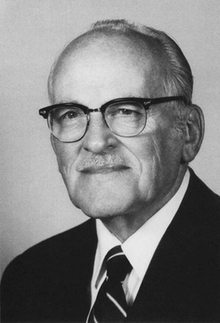Francis O. Schmitt
This article includes a list of general references, but it lacks sufficient corresponding inline citations. (March 2013) |
Francis O. Schmitt | |
|---|---|
 | |
| Born | November 23, 1903 St. Louis, Missouri, United States |
| Died | October 3, 1995 (aged 91) |
| Nationality | American |
| Citizenship | American |
| Alma mater | Washington University in St. Louis |
| Known for | Electron microscopy |
| Awards | Albert Lasker Award (1956), Alsop Award in 1947, and the T. Duckett Jones Award in 1963 |
| Scientific career | |
| Fields | Biology |
| Institutions | MIT |
| Doctoral students | Otto Schmitt Marie Jakus |
Francis Otto Schmitt (November 23, 1903 – October 3, 1995) was an American biologist and Institute Professor at the Massachusetts Institute of Technology.
Schmitt was born November 23, 1903 to Otto and Clara Schmitt, in South St. Louis, Missouri. He had two siblings, Otto and Viola. Schmitt's father owned and operated a paint and wallpaper supply store that he established with his father in-law. The store was located on the first floor of the three story family home. The family rented out the second floor apartments and lived in the eight rooms on the third floor (Schmitt, 6–8).[1]
Schmitt received an A.B. in 1924 and a Ph.D. in physiology in 1927 from Washington University in St. Louis.[2] During a summer research program at the Marine Biological Laboratory at Woods Hole, Massachusetts in 1923, he worked with Haldan Keffer Hartline under the supervision Jacques Loeb and Thomas Hunt Morgan. Schmitt joined the faculty in 1929 and taught zoology until 1941. He collaborated extensively with Arthur H. Compton to develop x-ray diffraction techniques for biological macro-structures like muscles and nerves.
Some of Schmitt's and his colleagues' most promising work was done with collagen, fibrinogen, striated, and smooth muscle, along with the fibrous proteins of neurons (Schmitt, 150). In 1952, Schmitt was working with two British students in order to teach them about electron microscopy. Using this new technology, these two students proposed the Sliding Filament Theory of muscle contraction. Ground breaking research was constantly coming out of his lab.[1]
In 1941, Schmitt was recruited by MIT's Karl Compton and Vannevar Bush to lead radically new Department of Biology there that would combine biology, physics, mathematics, and chemistry. Schmitt became an authority on electron microscopy and conducted innovative studies on kidney function, tissue metabolism, and the chemistry, physiology, biochemistry, and electrophysiology of the nerve. He became Institute Professor in 1955 and professor emeritus in 1973. In 1962, Schmitt helped to found the Neurosciences Research Program and served as its chairman from 1962 to 1974. Schmitt was a member of the National Academy of Sciences, the American Philosophical Society, and a former president of the Electron Microscope Society of America. He was awarded the Albert Lasker Award in 1956, the Alsop Award in 1947, and the T. Duckett Jones Award in 1963.
References
- Notes
- ^ a b Schmitt, Francis (1990). The Never Ceasing Search. The American Philosophical Society.
- ^ Schmitt, Francis (1982-06-07). "Francis Otto Schmitt, 1982". Washington University School of Medicine Oral History Project (Interview). Interviewed by Paul G. Anderson. Washington University School of Medicine. Retrieved 2021-08-07.
- Sources
- "Institute Professor Francis O. Schmitt dies at 91". MIT News Office. October 4, 1995. Retrieved 2007-03-24.
- Bloom, Floyd E. (December 1997). "Francis O. Schmitt (23 November 1903 – 3 October 1995)". Proceedings of the American Philosophical Society. 141 (4): 505–508. JSTOR 987226.
- 20th-century American educators
- Massachusetts Institute of Technology School of Science faculty
- Washington University in St. Louis alumni
- Scientists from St. Louis
- Scientists from Missouri
- 1903 births
- 1995 deaths
- Recipients of the Albert Lasker Award for Basic Medical Research
- Members of the United States National Academy of Sciences
- American scientists
- American physiologists
